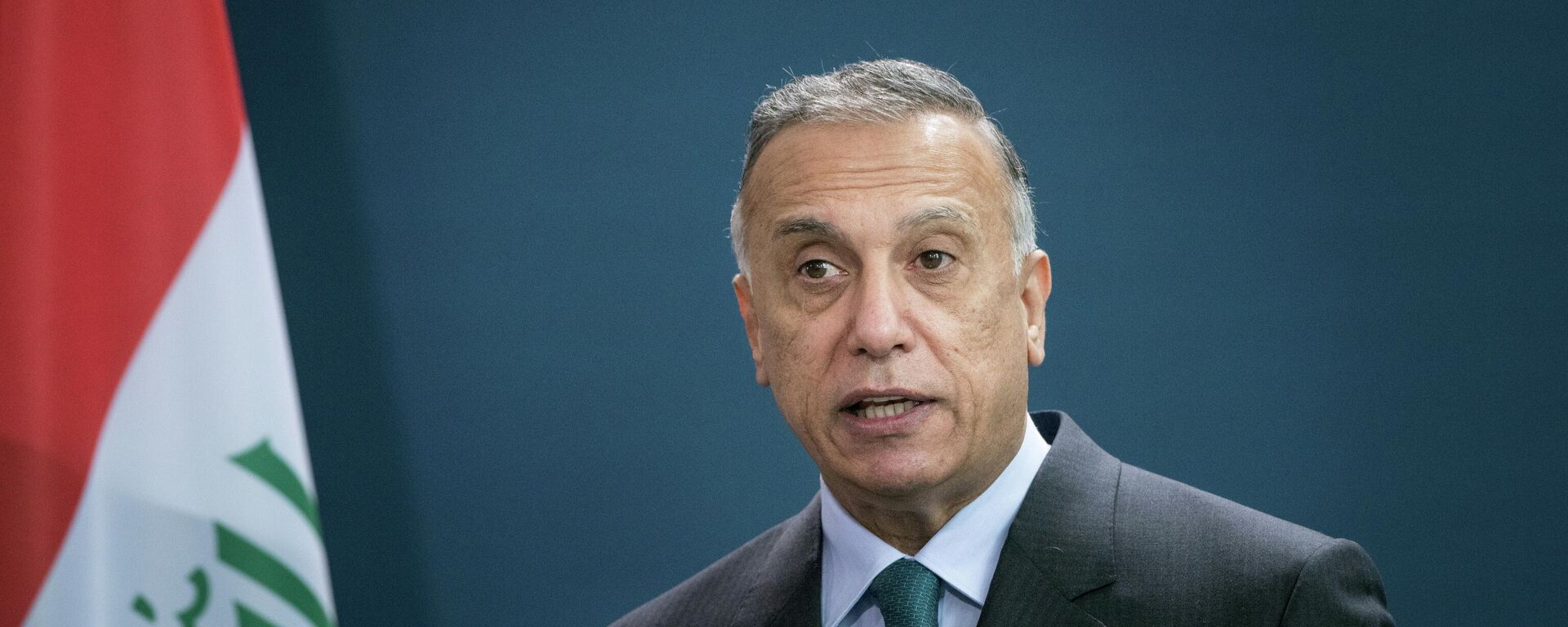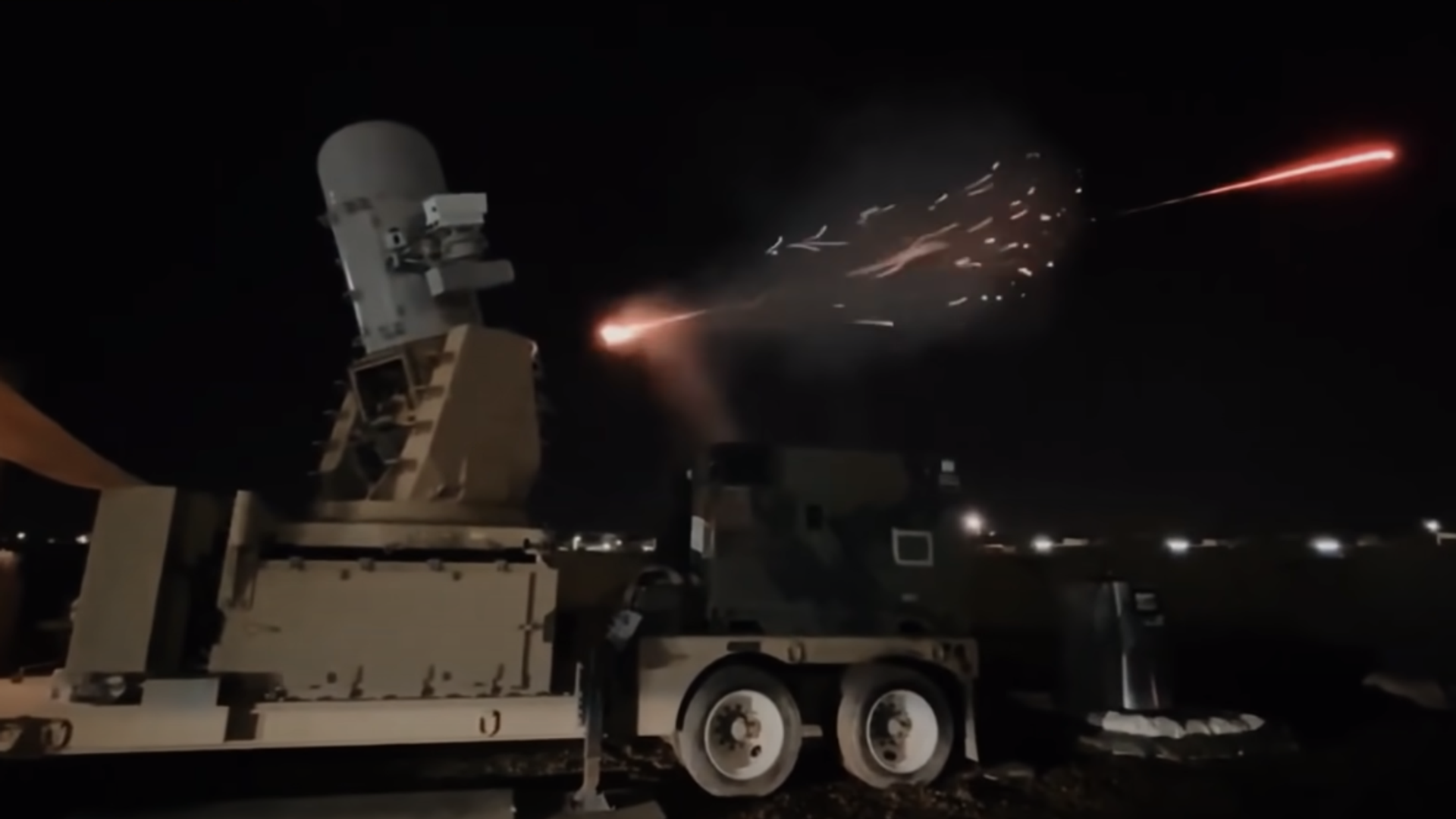https://sputnikglobe.com/20211108/iraqi-security-forces-ask-why-us-defences-in-baghdad-werent-working-during-uav-attack-on-pms-home-1090574011.html
Iraqi Security Forces Ask Why US Defences in Baghdad Weren’t Working During UAV Attack on PM’s Home
Iraqi Security Forces Ask Why US Defences in Baghdad Weren’t Working During UAV Attack on PM’s Home
Sputnik International
Iraqi Prime Minister Mustafa al-Kadhimi survived an assassination attempt early Sunday morning after three drones targeted his residence, situated in the... 08.11.2021, Sputnik International
2021-11-08T19:02+0000
2021-11-08T19:02+0000
2023-01-08T16:43+0000
green zone
drone attack
iraq
https://cdn1.img.sputnikglobe.com/img/07e5/0b/08/1090574189_84:0:1264:664_1920x0_80_0_0_e806639b10f41684fb370e483b2f0b7c.png
Iraq’s Joint Operations Command (JOC) is asking why the US military’s counter rocket, artillery and mortar (C-RAM) installations appeared to have been inoperable during Sunday morning’s attack on the prime minister’s residence.While operational, the C-RAM system sounds sirens to warn of potential incoming attacks, and fires off rapid-fire machineguns to shoot down hostile air targets. The system was installed and activated last year amid repeated strikes on the Green Zone by militia rocket artillery following the January 2020 US assassination of Qasem Soleimani, a senior Iranian anti-terror commander. After its installation, the system has been repeatedly used to protect Green Zone airspace. However, it has not always been accurate, with a volley of rockets launched into the Green Zone in February failing to activate the system, reportedly after it was projected that the rockets would not land within the diplomatic compound.Shia Militias SuspiciousHe went on to claim that “the fictitious explosion and gunfire” at the prime minister’s residence were “meant to conceal yesterday’s crimes, and destined to engage public attention,” in reference to the violent clashes between security forces in Baghdad and protesters demonstrating against the results of the 10 October election, which some Iraqi parties allege were ‘rigged’, on Friday.No group has claimed responsibility for Sunday’s attack. However, Asa’ib Ahl al-Haq was put under the spotlight Sunday after its leader, Qais al-Khazali, was seen in a viral clip warning that the prime minister would be made to “pay the price” for violence against the protesters.Sheikh Ali al-Asadi, chief of the political council of the al-Nujaba Movement, another Iraqi Shia paramilitary group, also alleged foul play in Sunday’s incident, suggesting that the Americans were trying to unleash chaos in Iraq.“All evidence and signs indicate that the American Embassy is involved in the incident,” he claimed. “If the evil American Embassy is found responsible for the attack, the seditionist US ambassador must then be expelled from Iraq,” al-Asadi insisted.Brazen AttackAl-Kadhimi emerged unscathed in the wake of Sunday’s bomb-laden drone attack, with the incident leaving six security guards injured and causing damage to the prime minister’s residence. Al-Kadhimi took to twitter to call for calm. Later, in an extraordinary session of the council of ministers, he promised to “pursue the perpetrators of Sunday’s crime,” saying the government “know[s] them very well and…will expose them.”The army was deployed across the capital in the aftermath of the attack to maintain order.Iraqi President Barham Salih, powerful Shia cleric Muqtada al-Sadr, Kurdistan Region president Nechirvan Barzani and others each condemned the attack and expressed relief that al-Kadhimi wasn’t hurt. Brig. Gen. Esmail Qaani, commander of Iran’s Revolutionary Guard Quds Force, reportedly flew to Baghdad on Sunday afternoon to meet with al-Kadhimi and Salih and call for calm and stability.Tehran slammed the attempt on the prime minister’s life. Foreign Ministry spokesman Said Khatibzadeh indirectly accused the US of involvement, saying Sunday “such incidents are in the interest of those who have violated the stability, security, independence and territorial integrity of Iraq over the past 18 years.”The US State Department offered assistance to investigate the incident. President Joe Biden “strongly condemned” Sunday’s attack, and praised al-Kadhimi for his “calm” and “restraint” in protecting Iraq’s state institutions and “strengthening” the war-torn nation’s democracy.
https://sputnikglobe.com/20211107/iran-slams-assassination-attempt-against-iraqi-pm-says-us-may-have-been-responsible-1090547580.html
https://sputnikglobe.com/20211107/iraqi-interior-ministry-calls-attempt-on-pms-life-a-terrorist-attack-1090540749.html
https://sputnikglobe.com/20211107/biden-strongly-condemns-terrorist-attack-on-iraqi-pms-residence-1090549220.html
iraq
Sputnik International
feedback@sputniknews.com
+74956456601
MIA „Rosiya Segodnya“
2021
News
en_EN
Sputnik International
feedback@sputniknews.com
+74956456601
MIA „Rosiya Segodnya“
Sputnik International
feedback@sputniknews.com
+74956456601
MIA „Rosiya Segodnya“
green zone, drone attack, iraq
green zone, drone attack, iraq
Iraqi Security Forces Ask Why US Defences in Baghdad Weren’t Working During UAV Attack on PM’s Home
19:02 GMT 08.11.2021 (Updated: 16:43 GMT 08.01.2023) Iraqi Prime Minister Mustafa al-Kadhimi survived an assassination attempt early Sunday morning after three drones targeted his residence, situated in the heavily fortified area of Baghdad known as the Green Zone. In addition to the prime minister’s home, the area houses the US Embassy and other diplomatic buildings.
Iraq’s Joint Operations Command (JOC) is asking why the US military’s counter rocket, artillery and mortar (C-RAM) installations appeared to have been inoperable during Sunday morning’s attack on the prime minister’s residence.
“We are currently discussing the matter with the American side and officials from the US Embassy. This is an issue that experts should throw light on and explain,” JOC spokesman Maj. Gen. Tahsin al-Khafaji said, his remarks
cited by Iran’s PressTV.
While operational, the C-RAM system sounds sirens to warn of potential incoming attacks, and fires off rapid-fire machineguns to shoot down hostile air targets. The system was installed and activated last year amid repeated strikes on the Green Zone by militia rocket artillery following the January 2020 US assassination of Qasem Soleimani, a senior Iranian anti-terror commander. After its installation, the system has been repeatedly used to protect Green Zone airspace. However, it has not always been accurate, with a volley of rockets launched into the Green Zone in February
failing to activate the system, reportedly after it was projected that the rockets would not land within the diplomatic compound.

7 November 2021, 14:56 GMT
Mahmoud al-Rubaie, a spokesperson for the Al-Sadiqoun Bloc, the political wing of the Asa’ib Ahl al-Haq Shia paramilitary group, has
alleged that the reported deactivation of the US C-RAM installations during the attempt on al-Kadhimi’s life may be an indication that the incident was a false-flag attack.
He went on to
claim that “the fictitious explosion and gunfire” at the prime minister’s residence were “meant to conceal yesterday’s crimes, and destined to engage public attention,” in reference to the violent clashes between security forces in Baghdad and protesters demonstrating against the results of the 10 October election, which some Iraqi parties allege were ‘rigged’, on Friday.
No group has claimed responsibility for Sunday’s attack. However, Asa’ib Ahl al-Haq was put under the spotlight Sunday after its leader, Qais al-Khazali, was seen in a viral clip warning that the prime minister would be made to “pay the price” for violence against the protesters.
Abu Ali al-Askari, a senior commander in Iraq’s Kata’ib Hezbollah militant group, also challenged the assassination plot narrative, claiming that “no one in Iraq is willing to squander a drone and fly it over the prime minister’s residence,” and alleging that “playing the victim is a timeworn tactic.”
Sheikh Ali al-Asadi, chief of the political council of the al-Nujaba Movement, another Iraqi Shia paramilitary group, also alleged foul play in Sunday’s incident, suggesting that the Americans were trying to unleash chaos in Iraq.
“All evidence and signs indicate that the American Embassy is involved in the incident,” he claimed. “If the evil American Embassy is found responsible for the attack, the seditionist US ambassador must then be expelled from Iraq,” al-Asadi insisted.

7 November 2021, 07:23 GMT
Al-Kadhimi emerged unscathed in the wake of Sunday’s bomb-laden drone attack, with the incident leaving six security guards injured and causing damage to the prime minister’s residence. Al-Kadhimi took to twitter to call for calm. Later, in an extraordinary session of the council of ministers, he promised to “pursue the perpetrators of Sunday’s crime,” saying the government “know[s] them very well and…will expose them.”
The army was deployed across the capital in the aftermath of the attack to maintain order.
Iraqi President Barham Salih, powerful Shia cleric Muqtada al-Sadr, Kurdistan Region president Nechirvan Barzani and others
each condemned the attack and expressed relief that al-Kadhimi wasn’t hurt. Brig. Gen. Esmail Qaani, commander of Iran’s Revolutionary Guard Quds Force,
reportedly flew to Baghdad on Sunday afternoon to meet with al-Kadhimi and Salih and call for calm and stability.
Tehran slammed the attempt on the prime minister’s life. Foreign Ministry spokesman Said Khatibzadeh indirectly accused the US of involvement,
saying Sunday “such incidents are in the interest of those who have violated the stability, security, independence and territorial integrity of Iraq over the past 18 years.”
The US State Department
offered assistance to investigate the incident. President Joe Biden
“strongly condemned” Sunday’s attack, and praised al-Kadhimi for his “calm” and “restraint” in protecting Iraq’s state institutions and “strengthening” the war-torn nation’s democracy.

7 November 2021, 18:02 GMT






